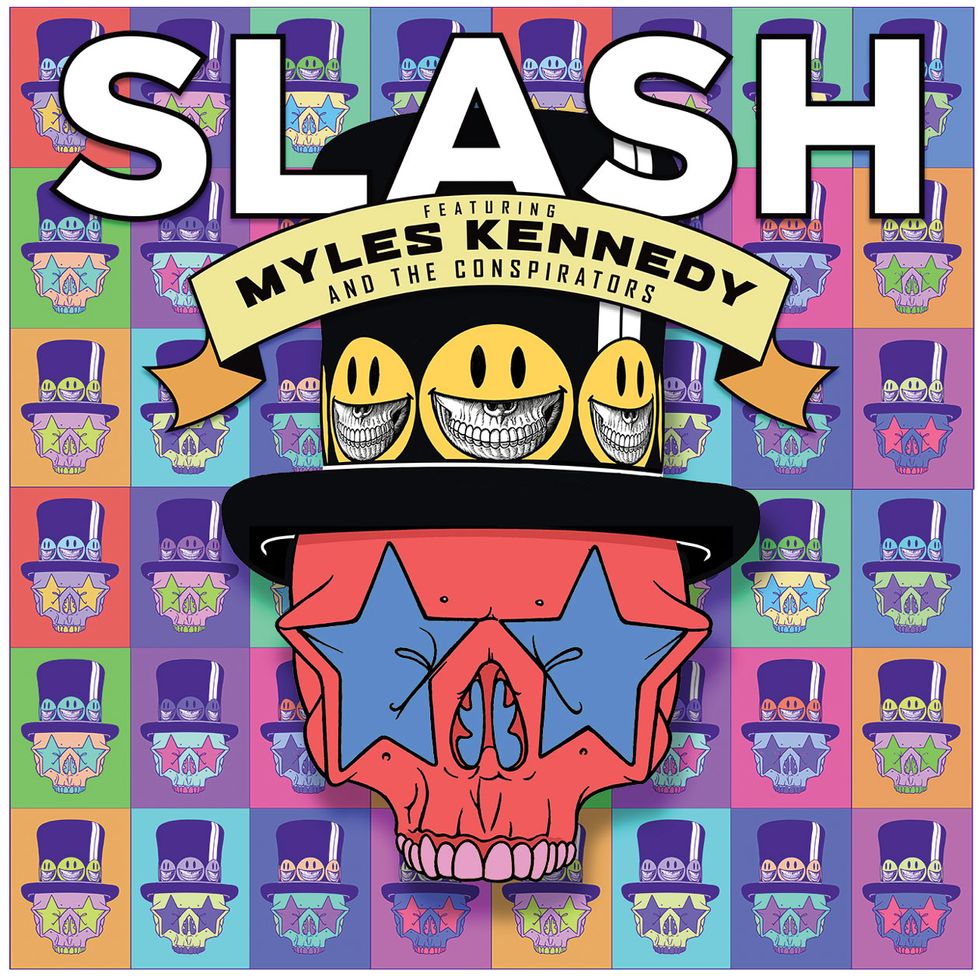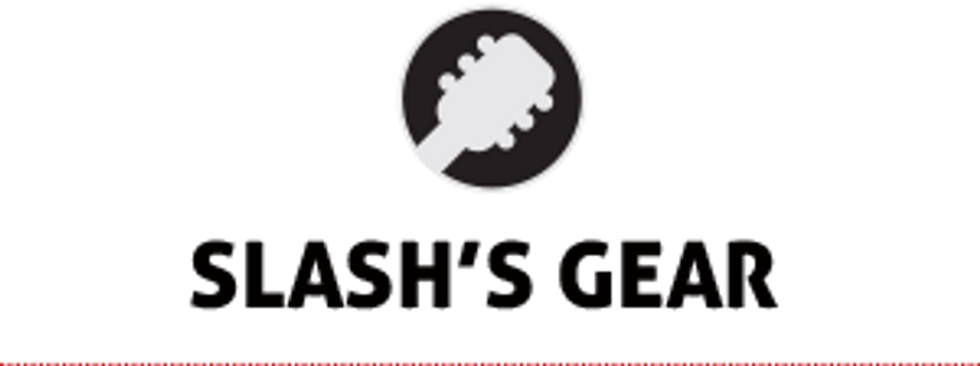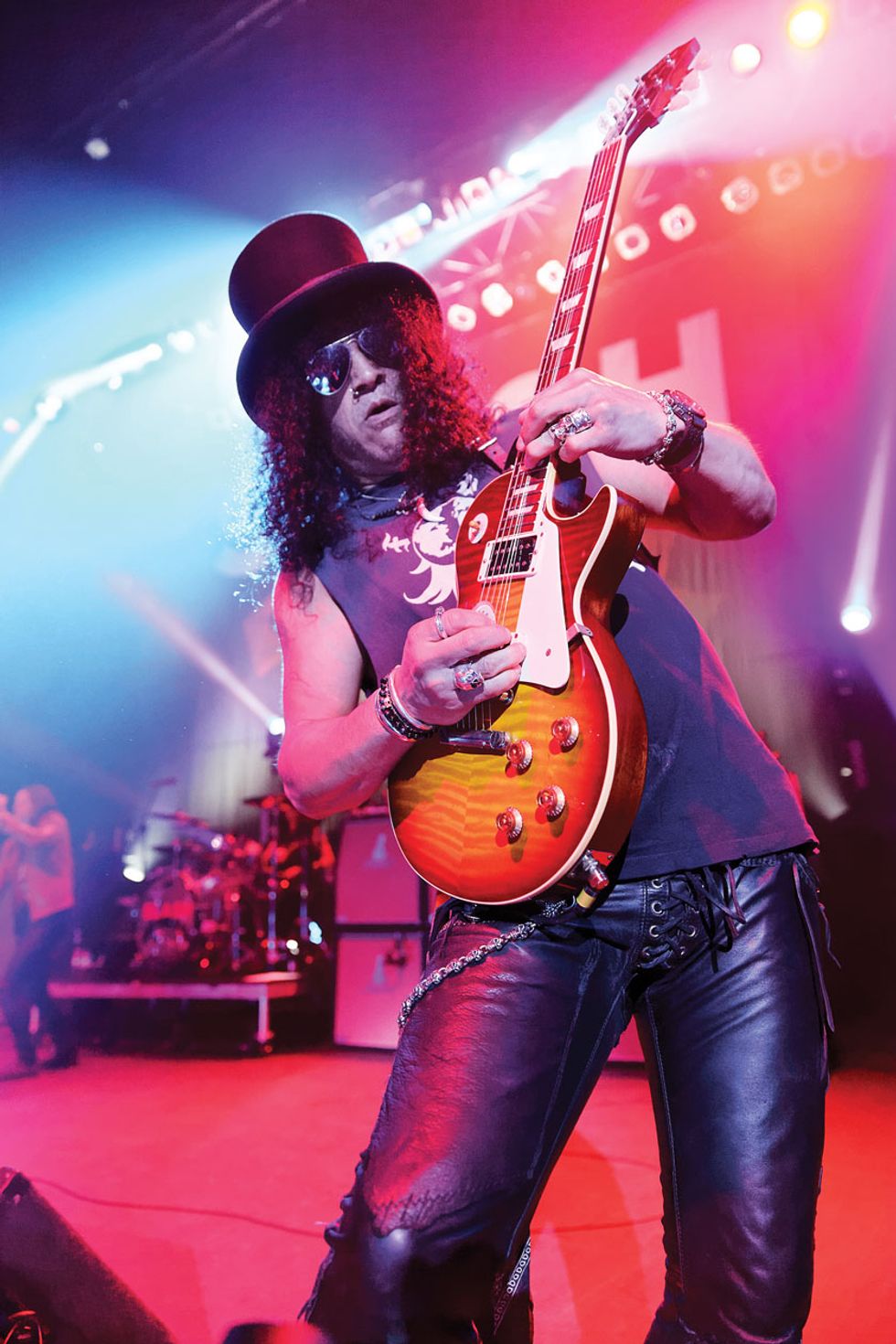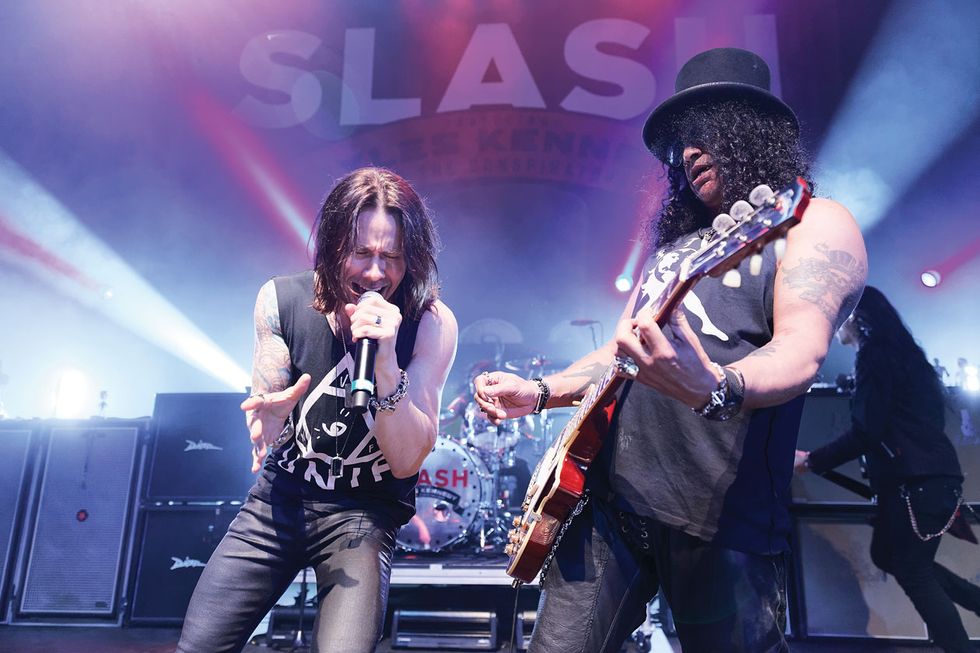Thousands of kids wear Slash costumes on Halloween each year. (Full disclosure: My kid dressed up as Slash last year, too.) Top hats, black curly wigs, and leather are ubiquitous in October, which—if nothing else—is a testament to Slash’s massive cultural impact.
Iconography aside, Slash’s stature as a guitarist is even bigger. Case in point: His opening lick to the Guns N’ Roses classic “Sweet Child O’ Mine” replaced “Stairway to Heaven” as the go-to riff that beginning guitarists played to flaunt their skills in guitar stores. (It’s possible that “Seven Nation Army” now holds that distinction, but “Sweet Child O’ Mine” dominated for decades.) He’s been called the “Last Guitar Hero”—and his image was central to the branding of the video game, Guitar Hero III—but it was his arrival in the late ’80s that cemented his legacy. In a world of big hair and synths, the Les Paul-playing Slash was a breath of fresh air—a vision of a better tomorrow.
It’s been more than 30 years since Appetite for Destruction, Guns N’ Roses’ debut, but Slash is no relic from the past. From GNR’s tumultuous initial run, through Slash’s Snakepit, Velvet Revolver, his solo outings backed by Myles Kennedy and the Conspirators, and his long-awaited never-thought-possible reunion with Axl Rose, Slash is a consistent presence and an ambassador for the primacy of guitar-centric rock.
But what’s more, Slash somehow keeps getting better.
Compare his playing on his most recent solo release, Living the Dream, to his earlier output. This is no lazy rock star resting comfortably on his laurels. It’s obvious he works on his craft. Although if you ask him, he downplays it. “I have a hard time seeing myself doing what I consider most lead guitar players doing these days,” he says. “Which is working on runs, patterns, and fucking dexterity. I’m just playing my guitar all the time.”
But whatever he calls it, guitar playing is his obvious focus. He still looks cool—and kids still want to be him—but his mission is music. He keeps busy, works hard, and, despite his almost elder statesman status, manages to stay relevant.
We caught up with Slash at the end of his tour in support of Living the Dream, his third album with Myles Kennedy and the Conspirators, and as he was getting ready for the final leg of GNR’s Not in This Lifetime… Tour. He shared his approach to working with the Conspirators, his recording and songwriting methods, his bare-bones signal chain, and his insights into working with a second guitarist. We also spoke with Myles Kennedy (see accompanying sidebar), who, although he limits himself to vocals with Slash, is a world-class guitarist in his own right.
Do you practice all the time? It sounds like you keep getting better.
Yeah, I definitely play. Obviously, I tour a lot, and in between tours I’m always recording, so I’m always playing. I think that’s where the practicing sort of shows up—just playing every night and improvising a lot. I think that’s where the growth is. If I sit home and just play my guitar, it’s really just to write or if I have an idea or something like that. I do warm-up scales or whatever I can come up with, but I’m not really what you’d call an ardent practicer. I don’t sit down and work on runs or theory or studiously work on my hand technique. It’s really more just playing all the time and growing as a player that way.
You’re not one of these guys who sit in front of the TV playing all day long?
I keep a guitar with me at all times, and if I’m sitting in my hotel room, sitting on the bed watching TV, I’ve got my guitar in my hands for sure.
What’s your approach to recording the band?
We rehearse—we call it preproduction—if I come up with a new idea and present it to the band. It could be anywhere: It could be at soundcheck, it could be just a riff on the bus or in the dressing room or something like that, and when we’re on tour, that’s where all the ideas sort of happen. When the tour’s over, we go into a room and start jamming together. We’re all there. We work on the riff, and whatever arrangement I’ve got going on, and Myles is coming up with melodies. We just work on all that together.
And then you record the tracks live?
We do a hell of a lot of preproduction, rehearsing, so we can just play the songs in one or two takes live. Sometimes there might be three or four takes just to get the feel right. When we actually go into the recording studio, we’ve got all the songs down and we go in and jam them out real quick.
Do you do extra guitars later by yourself?
Yeah.
I heard you like to stand in the control room when you’re recording your solos.
For the most part. Sometimes I’ll go into the booth, into the sound room, but I like to do everything really loud in the control room.

Living the Dream marks the first time Slash’s touring rhythm guitarist, Frank Sidoris, appears on a Slash featuring Myles Kennedy and the Conspirators’ album. On previous albums, Slash handled all guitar work in the studio.
How do you get your guitars to feed back when you’re in the control room?
Yeah, that has been a thing. I’ve been working on ways of doing that forever. Sometimes I can get the feedback I want out of the monitor in the control room. When we did the Apocalyptic Love record, which was a couple of records ago, we actually built a room called the Slash Box. I was in the room with big monitors and a Marshall all competing together. I could get full-on, automatic response from my cabinet, without having headphones on. That sort of worked. There’s no perfect formula for that. I will go out to the room in front of my amp with headphones if there’s something in particular that I’m trying to achieve feedback-wise. But the thing is, the amp is so loud. Headphones have a hard time competing with that, but I work it out one way or the other.
Do you bring your live rig into the studio?
When I’m on the road, I take primarily new guitars and amps. When I’m in the studio, I might take one of my road amps in the studio. Like the amp I used on this record was a brand-new Jubilee that I just got from Marshall that sounded good. But on this record—are you familiar with the Kris Derrig Les Paul I’ve been using since 1986? That was only a road guitar in 1987 and I retired it to just being a studio guitar. But on this record, I primarily use vintage guitars. I use the Derrig for one or two songs. I use a ’56 goldtop, a ’59 standard, and a ’58 that I have. Those guitars I would never take on the road, because I’m way too hard on guitars when I’m touring.
In the studio, Slash uses his prized replica ’59 Kris Derrig Les Paul and ’50s-vintage models, but he brings new Les Paul reissues on the road. “I’m way too hard on guitars when I’m touring,” he says. Photo by Ken Settle
Tell us about your B.C. Rich guitars.
I have an affinity that goes back to when I first started playing guitar. My first good electric guitar was a B.C. Rich Mockingbird. I eventually graduated to Les Pauls. But I still have a soft spot in my heart for B.C. Riches, and they sound good—the old ones sounded real good. I’ve had a couple new ones that they made for me that sound really good, too. I use those on the road, but I don’t use them in the studio that much because I’m a creature of habit in the studio. I like to have a Les Paul—it makes me feel comfortable.
Do your B.C. Riches have all the bells and whistles? Like the preamps and Varitone switches?
I don’t use any of that stuff [laughs]. I disconnect all of them. It looks cool.
Do you use any newfangled pedals or plug-ins?
I pretty much don’t, man. I have the wah pedal, which I use here and there. Sometimes I'll use a little bit of a phase on something. I know I did a little bit of a Phase 90 on one of the songs on the record. I don’t remember which one. But for the most part, I manage to get whatever it is that I’m looking for just with the amp and the guitar. You know, there is a delay here and there—little tricks, that at this point are seemingly redundant to people who are really into pedals. They’re just textures that you might use for whatever.
Your signal chain is guitar, wah, amp.
Yeah. It’s funny, too, because I have tons of pedals. I love collecting stompboxes. But I always find when I use them in the studio that they’re just a little too synthetic sounding for me—unless you’re really looking for a particular sound, like an octave fuzz, which is a very specific sound—but a lot of these different stompboxes have their own character. When it comes to the context of the song, I find that I never really need them or I don’t feel comfortable using them. They just take up a lot of space in my closet in the studio.
Do you ride the volume knob on the guitar to control the gain?
It depends. The amp pretty much stays. There are two different settings for the amp: There’s the rhythm setting that I use for all the rhythm tracks and then I’ll goose that up a bit for the solo stuff. During the rhythm tracks, I might ride the volume on my guitar a little bit—even when we’re recording—and then for the solos everything is usually just flat out.
On some of the songs on your new album, like “The Call of the Wild,” you have a cool jangly tone. Are you using something other than a Les Paul?
No, that’s the ’56 goldtop with soap bars. It’s funny, because I’ve never recorded with one before and I would hardly ever be seen using one—because I am such a humbucker-type guy—but for that particular song, for the detail of that riff, the humbuckers were just a little too muddy. I pulled this ’56 out that I’ve had since the ’90s, and I was like, “This is perfect.” I ended up using that goldtop for a lot of the record.
You almost always play with a second guitar player. No desire to do a power trio?
Not really. Frank [Sidoris, rhythm guitar] has been in the band for a while. He comes in at the end, when we’re putting the stuff together—at this point anyway, that’s how it seems to be working. I jam with Brent [Fitz, drums] and Todd [Kerns, bass], and we come up with these ideas, the three of us. I’ll bring in an idea, work out the parts, and get the whole groove going with those guys. Sometimes it’s just with the drummer, Brent, just to work up an idea and get a riff going. But we work these songs out, the three of us, and then Frank comes in and starts putting stuff on top of that. So I play in a power trio a lot, but as far as what I want the band to sound like, it’s always been, for me, a two-guitar band.

Guitars
Kris Derrig 1959 Les Paul replica
1956 Gibson Les Paul with soap bar pickups
1959 Gibson Les Paul Standard
1958 Gibson Les Paul
Amps and Effects
Marshall Jubilee
Dunlop Signature Cry Baby Wah
MXR Phase 90
Strings and Picks
Ernie Ball Power Slinky RPS (.011–.048)
Dunlop Tortex 1.14 mm
Is Frank on the album?
This is the first record he’s played on. The last couple of records it’s just been me. Myles played a little bit on Apocalyptic Love, but on the World on Fire record, I tried to have dual personalities. I did my parts on the right and then I did something that it didn’t sound exactly like me on the left. But it just doesn’t work like that because I have a particular approach to guitar playing that you can’t … I can’t pretend not to sound like myself. When Frank came into it, he added. I think that’s one of the things that makes the new record sound so good. It’s that there are two distinct personalities' sounds on the guitar—identifiable differences between the two sides, and that’s what I’m going for.
Do you spend time talking about tones and divvying up duties, or is it more organic?
It’s more organic. I’ve never been one to sit there and analyze what the other person is doing, or how what I’m doing compares to what the other person is doing or working out specific dual-guitar runs or anything. On occasion, I might. There are a couple of moments here and there where I might go, “Frank, try this.” I have maybe two different ideas in my head about how this part should go. I might tell him what the other part is, and he’ll play that, and I’ll play my part. But for the most part, he does his thing and I do mine.
How about Richard Fortus (rhythm guitarist in Guns N’ Roses since 2002)? Is it the same type of playing relationship as with Frank?
Richard’s great, man. It’s the same kind of thing. It’s not my personality, I guess, to want to concentrate on the two-guitar approach, even though I’m always in a two-guitar band. It’s always been, “You’ve got your thing, doing whatever you’ve got to do over there, and I’m doing whatever I do over here.” Usually they work together pretty well. If there’s something specifically that needs to get worked out, like with Richard—because a lot of that Chinese Democracy stuff, obviously, I didn’t have anything to do with writing it, so it was sort of foreign to me—he definitely had his parts and he showed me what some of the other parts were. We would jam the stuff and I would come up with my own interpretation of what those other parts were. But for the most part, Richard just does his thing and I do mine.
What’s next?
Guns is doing its final run on the Not in This Lifetime… Tour next month in Asia and South Africa and Dubai, and then that’s it until we can hunker down and do a record.
Is there a record in the works?We’ll see [laughs]. Right now, it’s just something that we’re all talking about.
Slash and his band rock the first single, “Driving Rain,” from Living the Dream on Jimmy Kimmel Live! in September 2018. Skip to 2:52 for the Slash solo.
Myles Kennedy and Slash have done three albums together. Kennedy played rhythm guitar on Apocalyptic Love, but focused on vocals only for World on Fire and Living the Dream. Photo by Ken Settle
Myles Kennedy: “Guitar Is Still My First Love”
Myles Kennedy, the lead singer in Alter Bridge, sings on Slash’s solo releases as well. But vocals are secondary to his main focus, which is guitar playing. Because of that, he is able to give us a guitarist’s insider perspective into the making of Living the Dream.You don’t play guitar in this band. Have you ever?
I did play on the Apocalyptic Love record. I played rhythm guitar parts on that. But since then, I just focus on the vocals, which has actually been really liberating in a lot of ways, because it allows me to focus solely on the melodies and lyrics. Between Alter Bridge and now solo stuff and this, time is definitely finite. It helps me have time to focus on certain aspects of the songs.
Do you miss not having a guitar onstage with you?
Absolutely. I mean [laughs], I kind of consider myself a guitar player first, singer second. Guitar is still my first love. I’m staring at a guitar right now. I’m probably going to play for the rest of the afternoon. It’s what I love.
Did you use your guitar for the writing for this album? Is it part of the demo process and writing?
No. You know, Slash pretty much has the music ready to go. Then he sends it to me and I come up with the melodies and the lyrics from that point forward. Occasionally, there'll be a song, like the first single, “Driving Rain.” I found this old email from about three years ago; he sent me what was the genesis of the music. That’s an example of where I actually came up with the chord progression and I did integrate a guitar, just for the sake of the melody, when the chorus hits. I was like, “Let’s try these chords. Have these chords in mind to sing the melody.” I sent it back to him and he was like, “Cool, we’ll put that in.” But other than that, 95 percent of it is what he comes up with and then I put the melodies on top.
Have you learned different things about Slash’s style or guitar playing just from working with him?
Yeah. I actually really love to watch Slash play and it’s cool. Sometimes he gets so lost in the moment and he’ll turn around and be facing the drummer and I, Brent and I, and I don’t even know if he knows that he’s not facing the crowd. I’m like, “Cool, I get my own show here.” His hands are like literally two feet in front of me. As I watch him weave around the neck, what I notice is his strength. You can tell, he’s got very strong hands. He has such command of the instrument. What I love about Slash’s playing is he has an incredible amount of technique, but he integrates so much soul and so much fire and passion, the passion of a blues player, and on top of that he has this very unique technique. I think that’s what makes him such an anomaly and it’s really special.
You can hear from Appetite until now that there’s a real evolution in his playing. Does he practice?
Absolutely. I don’t think I’ve ever met anybody who has the need and desire to play like that guy. He has to be playing. He’s got such passion for it. It’s very inspiring for me to see that. Obviously, with the amount of success that he’s had, he doesn’t have to do this. If he wants, he can go hang out at the beach somewhere. But he has to play. It’s in his DNA and I think it’s what makes him happiest.
Do you bring a guitar on tour?
Absolutely [laughs]. I’m miserable without one. I tried that a few times, especially on the first few tours with Slash, where there was a lot of flying. We went to Japan, China, wherever, and I thought, “Do I really want to cart a guitar around the whole time, from hotel room to hotel room, and take it on the plane?” I learned my lesson. I went about half mad not having that. By the time I’d get to the room I’d be climbing the walls, like, what am I going to do with myself? I’ve got to have a guitar with me all the time.
What do you work on?
I do a lot of writing. Right now, I’m preparing the next Alter Bridge record. Mark [Tremonti] and I have been exchanging ideas. But I’m also always trying to learn new tricks. With things like YouTube and whatever else you can find online, I try and learn new things. I was going through a Danny Gatton phase recently—trying to learn a few of his licks. Trying to incorporate whatever other players have into my vocabulary to use, especially in improvisational settings.
Do you recommend people take lessons and learn theory?
I do. I think it was a quote I saw by Billy Sheehan a long time ago. He said, “You’ve got to know the rules before you can break them.” I like that. I studied. I actually took two years of music school after I graduated from high school, at community college, and learned theory and even learned how to arrange for big bands. I learned a lot, especially about the jazz approach to theory. In a lot of ways, it’s come in useful. It is nice knowing that I’ve got that knowledge in my hip pocket if I need it. It is nice to touch on once in a while.

















![Rig Rundown: Russian Circles’ Mike Sullivan [2025]](https://www.premierguitar.com/media-library/youtube.jpg?id=62303631&width=1245&height=700&quality=70&coordinates=0%2C0%2C0%2C0)
















![Rig Rundown: AFI [2025]](https://www.premierguitar.com/media-library/youtube.jpg?id=62064741&width=1245&height=700&quality=70&coordinates=0%2C0%2C0%2C0)




















 Zach loves his Sovtek Mig 60 head, which he plays through a cab he built himself at a pipe-organ shop in Denver. Every glue joint is lined with thin leather for maximum air tightness, and it’s stocked with Celestion G12M Greenback speakers.
Zach loves his Sovtek Mig 60 head, which he plays through a cab he built himself at a pipe-organ shop in Denver. Every glue joint is lined with thin leather for maximum air tightness, and it’s stocked with Celestion G12M Greenback speakers.






